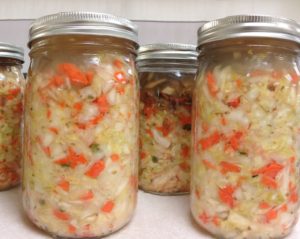
Fermentation is an ancient food preparation method that is gaining newfound popularity. It involves a range of foods, techniques, and types of microbes. Most people are familiar with fermented foods such as yogurt and sauerkraut. However, did you know that traditional corned beef is also fermented, and that the flavors of chocolate would not exist if the cacao beans were not fermented after harvest?
Fermentation helps preserve foods, which was especially important before refrigerators and chemical preservatives. It also creates unique flavors in foods that are beloved components of many local cuisines. Examples include kimchi in Korea, Stilton blue cheese in the United Kingdom, and igunaq (fermented walrus) in Canada. Furthermore, consuming fermented foods may come with added health benefits.
Health benefits of fermented foods
In spite of the long history of fermentation, we still do not fully understand the potential health benefits of fermented foods. Yet, there appears to be three primary ways in which fermented foods could improve health. Fermentation may:
- Increase the availability of nutrients in some foods. As microbes break down a food through fermentation, they may help release nutrients so that our bodies can more easily absorb those nutrients, making them more bioavailable, or more available for our bodies to use. Studies show that fermentation can increase the bioavailability of some proteins and minerals in foods such as grains, beans, and dairy.
- Contribute to the formation of new compounds such as organic acids, phenols, proteins, and antioxidants. These compounds play an active role in bodily functions and health, with beneficial properties ranging from being antimicrobial to inhibiting tumor growth.
- Provide a source of probiotics. Some microbes responsible for fermentation are called probiotics. Probiotics are live microorganisms that impart a health benefit to the person eating them, when consumed in adequate amounts. Studies have shown that probiotics may positively affect our digestion, mood, immune system, and metabolism.
Tips to include more fermented foods in your diet

As you can see, fermented foods have a range of potential health benefits. Below are some tips about how to add more fermented foods to your diet.
- Make your own sauerkraut or other fermented veggies. Check out the kimchi recipe located on the Colorado Farm to Table website to get started. Alternatively, look for fermented sauerkraut, kimchi, and pickles at your grocery store. Look for ones that are refrigerated, that do not have vinegar in the ingredients, and that say “raw” or “fermented” on the label. (Most of the pickles and sauerkraut found in grocery stores today are heated and made with vinegar, rather than fermented.)
- Use fermented veggies such as sauerkraut, kimchee, pickles, and carrots to top sandwiches, meats, salads, and even soups. Eat them as an appetizer, a side dish, or even a snack!
- Try your hand at sourdough bread. Learn the basics with the sourdough guide on the Colorado Farm to Table website. You can also buy sourdough bread. Look for bread that lists sourdough starter, rather than yeast, in the ingredients.
- Eat more yogurt. Try it with fruit and granola for breakfast, as an easy snack, as a base for dips, or as a substitute for sour cream. Read the yogurt label to make sure that it says it says “live and active cultures”. Steer away from yogurt that has a lot of added sugar. You can experiment with making your own, as well!
- Look for kombucha at your local grocery, or make this fermented tea at home. Find out how at Colorado Farm to Table. Try it plain or flavored!

Have fun trying out new fermented foods, and enjoy familiar ones as well. They are not only a delicious addition to our diets, but a healthy one, as well!
(Thank you to Janie Jacoby, a graduate student in the Department of Food Science Human Nutrition, for assisting with writing this article.)


I’ve got a batch of sauerkraut fermenting right now! I use my Korean kimchi container to make it, which is really nice because you can keep the cabbage continuously under liquid by pushing down the adjustable inner vacuum lid. I have several of the .9 gallon size, and almost always now have kimchi and/or sauerkraut available at our house!
https://www.amazon.com/Crazy-Korean-Cooking-Fermentation-Translucent/dp/B011VNRT12
Thanks for the information and great references. Once I learned to ferment my own sauerkraut, I will never buy it again. The taste and crunch are so much better than I could have imagined.
This was a great post to share with a lot of information…thanks